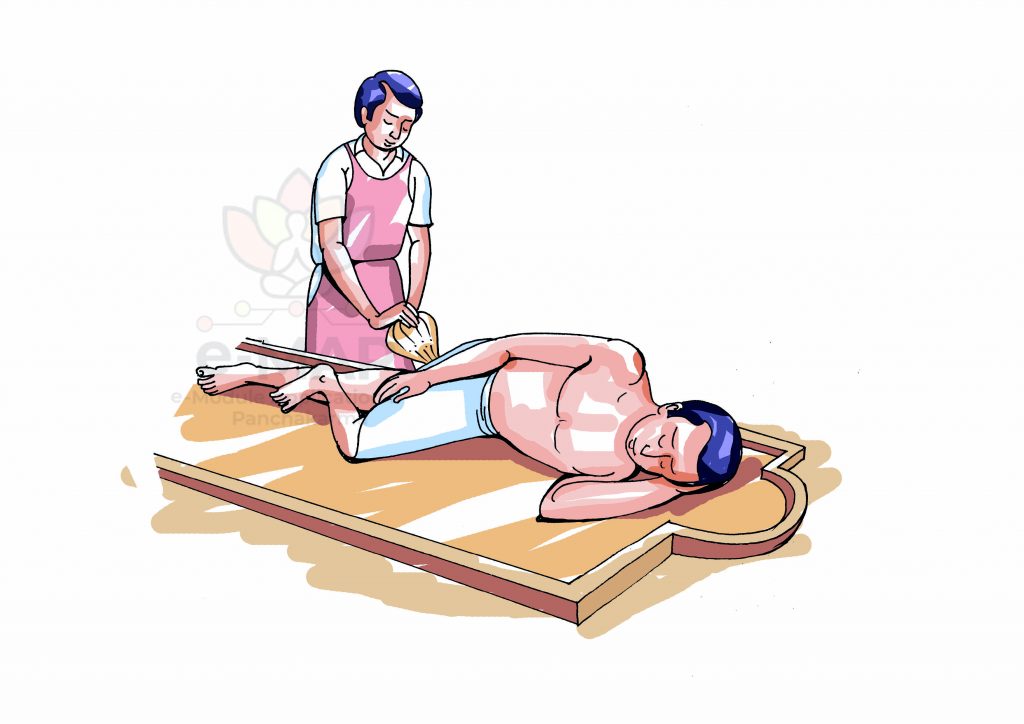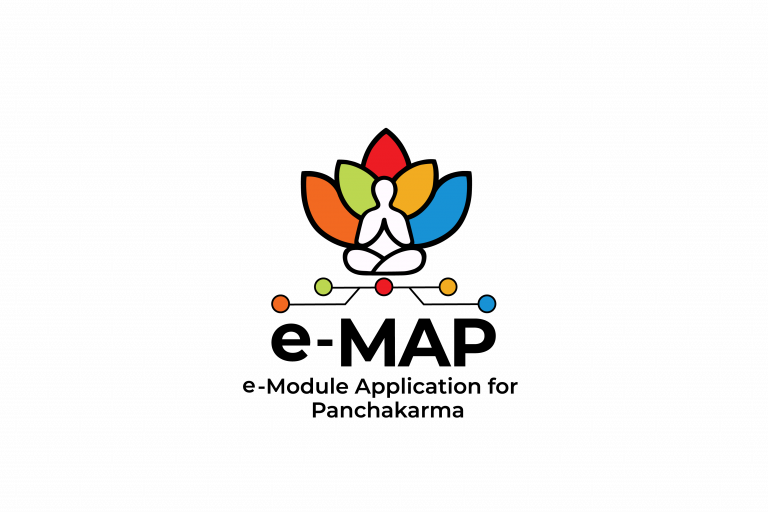
PG Module 6
BASTI KARMA

EXPLANATORY NOTES
- Pūrvakarma
- Pradhānakarma
- Paścātkarma
PŪRVAKARMA
- Preparation of the patient
द्वित्रास्थापनशुद्धेभ्यो विदध्याद्बस्तिमुत्तरम्|| (A. H. Su. 19/70)
Uttarabasti should be administered to those who have purified by 2-3 Nirūha Basti. In usual practice Nirūha Basti given in the morning and Uttara Basti in the afternoon.
अथातुरमुपस्निग्धं स्विन्नं प्रशिथिलाशयम् ||
यवागूं सघृतक्षीरां पीतवन्तं यथाबलम् | (Su. Chi. 37/8)
The patient should be given mild oleation and sudation in the lower abdomen, thighs and groins. The patient is asked to void urine and faeces and given Yavāgū added with ghee and milk as much as he can drink by his strength.
(b) Time of Administration
तेनपूर्वाह्णेचोत्तरबस्तिप्रणिधानम्| [i] (Su. Chi. 37/109, Dalhana commentary)
Uttarabasti should be administered in the morning time.
स्त्रीणामार्तवकालेतुयोनिर्गृह्णात्यपावृतेः ||
विदधीततदातस्मादनृतावपिचात्यते |
योनिविभ्रंशशूलेषुयोनिव्यापद्यसृग्दरे || [ii] (A. H. Su. 19/77-78)
For women, Uttarabasti should be administered during Ṛtukāla in which the Yoni or Garbhāśaya is without its closure (in other words, it is open) and thus can retain the drug. However, it can be administered even apart from the Ṛtukāla in emergency and in conditions like yoni Vibhraṃśa, Yoni Śūla, Yoni Vyāpat, Asṛgdara.
स्त्रीणामार्तवकालेतुप्रतिकर्मतदाचरेत् |
गर्भासनासुखंस्नेहंतदाऽऽदत्तेह्यपावृता ||
गर्भंयोनिस्तदाशीघ्रंजितेगृह्णातिमारुते | [iii] (Cha. Si. 9/62)
The uterus remains open during the Ṛtukāla and thus readily receives the Sneha Dravya given in the form of Uttarabasti. This therapy subdues the Vātaas a result of which the uterus become capable of conception.
(c) Position of the patient
उत्तानायाःशयानायाःसम्यक्सङ्कोच्यसक्थिनी|
ऊर्ध्वजान्वा |[iv] (A. H. Su. 19/70)
The Patient should be made to lie down in supine position with the legs folded at the knees and kept erect.
PRADHĀNA KARMA
अथास्याःप्रणयेन्नेत्रमनुवंशगतंसुखम्| ||[v] (Cha. Si. 9/68)
सम्यक्प्रपीडयेद्योनिंदद्यात्सुमृदुपीडितम् | | [vi] (Su. Chi. 37/115)
ऊर्ध्वजान्वास्त्रिचतुरानहोरात्रेणयोजयेत् ||
बस्तींस्त्रिरात्रमेवं च स्नेहमात्रांविवर्द्धयन् |
त्र्यहमेव च विश्रभ्यप्रणिदध्यात्पुनस्त्र्यहम् || (A. H. Su. 19/81-82)
Basti Netra should be inserted comfortably in the direction of the vertebral column. Medicine should be administered into the yoni by gently pressing the Puṭaka. It may be given 3-4 times in a day and night. In this way it should be continued for 3 consecutive days with increasing the quantity of Sneha. After a gap of 3 days it should be administered again for another 3 days.
PAŚCĀT KARMA
प्रत्यागतेद्वितीयंचतृतीयंचप्रदापयेत्| [vii] (Cha. Si. 9/57)
ततःप्रत्यागतस्नेहमपराह्णेविचक्षणः |
भोजयेत्पयसामात्रांयूषेणाथरसेनवा ||[viii] (Su. Chi. 37/113)
बस्तीननेनविधिनादद्यात्त्रींश्चतुरोऽपिवा||७६||
अनुवासनवच्छेषंसर्वमेवास्यचिन्तयेत् | [ix] (A. H. Su. 19/76)
After the medicine has come out, 2 – 4 Bastis should be administered in this manner .In the evening, after the oil has come out, the wise physician should ask the patient to take food in limited quantity along with milk, soup of pulses or soup of meat.
After the withdrawal of given drug, follow the postoperative regimen as that of Sneha Basti. Management of the complications is also similar to that of Sneha Basti.
MūtrāśayagataUttarabasti in practice
- Autoclave the medicine and all the instruments used for Uttarabasti.
- Patient is made to lie down in supine position with flexed legs by exposing the genital area.
- Wash the genitals and surrounding area with normal saline by using sponge holding forceps and gauze. Then apply betadine.
- The physician should spread the surgical towel over the patient, exposing the perineal area.
- The autoclaved medicine is filled in to the syringe
- After lubricating the catheter with xylocaine jelly, gently introduce it in to the urethra, then slowly to the bladder.
- Ensure that the catheter has entered the bladder. Then the fix the syringe to the catheter and slowly inject the medicine to the bladder.
- Remove the catheter after the injection is completed and take rest for 5-10 minutes.
GarbhāśayagataUttarabastiin practice
- Autoclave the medicine and all the instruments used for Uttarabasti.
- Patient is made to lie down in lithotomy position by exposing the genital area.
- Wash the genitals and surrounding area with normal saline by using sponge holding forceps and gauze.
- The physician should spread the hole towel over the patient, exposing the perineal area.
- Cervix is exposed using lubricated cuscus speculum and is cleaned with betadine.
- Then uterine sound is inserted to know the direction of uterus.
- The autoclaved medicine is taken in the syringe and fix the IV/IUI cannula or infant feeding tube to this. Then introduce it into the uterus through the cervix and Dravyais pushed slowly.
[i] Vaidya Yadavji Trikamji,Suśruta Samhita, with Nibandha śangraha commentary of Sree Dalhana ācharya and Nyayachandrika Panchaka of Sri gayadasa ācharya , edition -2014, Varanasi, Chikitsa Sthānan, Chapter-37, śloka109, p -538
[ii]Āchārya Vāgbhata, Aṣtanga Hridaya elaborated by Vāgbhata with joined commentaries of Āyurveda Rasayana by Hemadri and SarvangaSundari by Arunadatta, Haridasasiva Paradakara, edition- 2010, Varanasi, Chaukamba Sutrasthāna chapter 19, śloka 77-78,p-284
[iii] Vaidya Yadavaji Trikamji ācharya, Charaka Samhita with āyurveda deepika commentary of Chakrapānidatta revised by Charaka and Dhridhabala,reprint -2011, New delhi, Chaukambha surbhārti prakashan, Siddhisthāna,Chapter-9, Sloka-62, p-720
[iv]Āchārya Vāgbhata, Aṣtanga Hridaya elaborated by Vāgbhata with joined commentaries of Āyurveda Rasayana by Hemadri and SarvangaSundari by Arunadatta, Haridasasiva Paradakara, edition- 2010, Varanasi, Chaukamba Sutrasthāna chapter 19, śloka 70,p-283
[v] Vaidya Yadavaji Trikamji ācharya, Charaka Samhita with āyurveda deepika commentary of Chakrapānidatta revised by Charaka and Dhridhabala,reprint -2011, New delhi, Chaukambha surbhārti prakashan, Siddhisthāna,Chapter-9, Sloka-68, p-721
[vi] Vaidya Yadavji Trikamji,Suśruta Samhita, with Nibandha śangraha commentary of Sree Dalhana ācharya and Nyayachandrika Panchaka of Sri gayadasa ācharya , edition -2014, Varanasi, Chikitsa Sthānan, Chapter-37, śloka-115, p-538
[vii]Vaidya Yadavaji Trikamji ācharya, Charaka Samhita with āyurveda deepika commentary of Chakrapānidatta revised by Charaka and Dhridhabala,reprint -2011, New delhi, Chaukambha surbhārti prakashan, Siddhisthāna,, Chapter-9, Sloka-57 p-721
[viii] Vaidya Yadavji Trikamji,Suśruta Samhita, with Nibandha śangraha commentary of Sree Dalhana ācharya and Nyayachandrika Panchaka of Sri gayadasa ācharya , edition -2014, Varanasi, Chikitsa Sthānan, Chapter-37, śloka-113, p-538
[ix]Āchārya Vāgbhata, Aṣtanga Hridaya elaborated by Vāgbhata with joined commentaries of Āyurveda Rasayana by Hemadri and SarvangaSundari by Arunadatta, Haridasasiva Paradakara, edition- 2010, Varanasi, Chaukamba Sutrasthāna chapter 19, śloka 76,p-284
Both Kaṣāyaas well as Snehacan be used in. But in practice,Kaṣāyaare used as vaginal douche alone and not for intra uterine instillation.
Commonly used medicines[i]
- For intra uterine purpose – DhānvantaraTaila, BalaTaila,SahacarādiTaila,KalyānakaGhṛta,PhalaGhṛtacan be used.
- For bladder conditions like atonic bladder – DhānvantaraTaila can be used. The Pākaof oil should be Madhyama.
- ĀragvadhādiKaṣāya, TriphalāKaṣāya,NālpāmarādiKaṣāya can be used. They are commonly done in trichomonas vaginalis and candida albicans.
Sneha for Uttarabasti
- Śatāvarī Taila – YoniŚūla[ii]
- ĀgāradhūmādiTaila – YoniSrāva[iii]
- JīvanīyaSādhitaTaila[iv] – KaphaVāta Yoni Roga, AcaraṇaYoniVyāpat,ŚuṣkaYoni Roga
- NyagrodhādiSādhitaTaila –PrākcaraṇaYoniVyāpat,AticaraṇaYoni Vyāpat[v]
- Āgāradhūmādi/BalaTaila – YoniŚūla,Yoni Srāva[vi]
- PhalaGhṛta– Yoni Vyāpat[vii]
- TriphalaGhṛta– YoniVyāpat
- GuḍūcīādiTaila – YoniVyāpat
- ŚuṣkāntargataVarṇitaTaila – Aticaraṇa YoniVyāpat
- JīvanīyaGaṇaSiddha Dravya – Uttarabasti with the oil treated with Jīvanīyagroup of drugs should be givenin Karṇinī Yoni Vyāpat[viii]
KaṣāyaforUttarabasti[ix]
- Yoni Srāva –use of decoction made with the drugs of mainlyKaṣāya rasa (Nyagrodhādi, Udumbarādi)
- Yoni Roga – MahārāsnādiKvātha
- Yoni Srāva–Uttarabasti with decoction of stem bark of Lodhraand Vaṭashould be done
- LodhārdiGaṇa–blood stained,pinkish /other vaginal disorder
- MustādiGaṇa– blood stained, pinkish /other vaginal disorder
- AmlayuktaKvātha– Yoni Vyāpat
[i]Dr BA. Lohith.A text book of Panchakarma,Chaukhambha publication,Edition 2016,P 334
[ii]Prof.(K.M)Premvati Tewari,Ayurvediya Prasutitantra Evam Striroga Part2 Choukhambha Publication Edition 2000,P-212
[iii]Prof.(K.M)Premvati Tewari,Ayurvediya Prasutitantra Evam Striroga Part2 Choukhambha Publication Edition 2000,chapter 4,P.264
[iv]Vaidya Yadavaji Trikamji ācharya, Charaka Samhita with āyurveda deepika commentary of Chakrapānidatta revised by Charaka and Dhridhabala,reprint -2011, New delhi, Chaukambha surbhārti prakashan, chikitsasthāna,, Chapter-30, Sloka-103, p-639
[v]Prof.(K.M)Premvati Tewari,Ayurvediya Prasutitantra Evam Striroga Part2 Choukhambha Publication Edition 2000,chapter 4,P.265
[vi]Prof.(K.M)Premvati Tewari,Ayurvediya Prasutitantra Evam Striroga Part2 Choukhambha Publication Edition 2000,chapter 4,P.264
[vii]Prof.(K.M)Premvati Tewari,Ayurvediya Prasutitantra Evam Striroga Part2 Choukhambha Publication Edition 2000,chapter 1,P.79
[viii]Prof.(K.M)Premvati Tewari,Ayurvediya Prasutitantra Evam Striroga Part2 Choukhambha Publication Edition 2000,chapter 1,P.108
[ix]Prof.(K.M)Premvati Tewari,Ayurvediya Prasutitantra Evam Striroga Part2 Choukhambha Publication Edition 2000,chapter-1,P.80
Basti PratyāgamanaKāla
बस्तिर्मात्राशतादूर्ध्वंप्रत्यागच्छति, अनागच्छतिवर्तिंपायौनालेप्रदापयेत्इति
(Su. Chi. 37/117, Dalhana commentary)
The PratyāgamanaKāla for UttarabastiDravya is 100 Mātra. In the absence of UttarabastiDravyaPratyāgamana one may wait and neglect. If it is Upadravakāri it has to be expelled usingTīkṣṇaUttarabasti/Niruha Basti /Varti Prayoga.
Chikitsa for Apratyāgamana of bastidravya
- If Uttarabasti is not returned,anotherBastiprepared with Kaṣāya of ŚodhanaDravya is used in the dose of 1 and 2 PrasṛtainMūtraand Yoni Mārga respectively[i]
- ŚodhanaDravya siddha PhalaVarti.[ii]
- Probe is inserted in Mūtramārga and abdomen is pressed forcefully below the umbilicus. [iii]
- पिप्पलीलवणागारधूमापामार्गसर्षपैः|
वार्ताकुरसनिर्गुण्डीशम्पाकैःससहाचरैः||
मूत्राम्लपिष्टैःसगुडैर्वर्तिंकृत्वाप्रवेशयेत्|
अग्रेतुसर्षपाकारांपश्चार्धेमाषसम्मिताम्||
नेत्रदीर्घांघृताभ्यक्तांसुकुमारामभङ्गुराम्|
नेत्रवन्मूत्रनाड्यांतुपायौचाङ्गुष्ठसम्मिताम्|| [iv]
The Varti is to be prepared by Pippali,Lavaṇa, Apamārga, Sarṣapa,Nirguṇḍī,Śampāka,Sahacara processed in cow’s urine and Amlarasa.It is to be cooked in jaggery so that it becomes hard and smooth.Its tip should be like Sarṣapa where as its base is asMāṣa, it smeared with ghee, should be inserted into urethra or rectum.
- Varti of size of Mudga, Ela, Sarṣapa should be prepared by triturating ĀragvadhaPatra with Nirguṇḍī Patra Svarasa, Gomūtra and Saindhava and dried in shade. This Varti is smeared with Ghee and inserted into Mutramārga with the help ofŚalāka.[v]
- SthūlaVarti of 4 Aṅgulaprepared out of above said drugs is placed in Yonimārga to achieve the returning of Sneha.
- The treatment mentioned for the complications of Anuvāsana is to be applied if complications occur during Uttarabasti.[vi]
In case of Dāha
शर्करामधुमिश्रेणशीतेनमधुकाम्बुना ||
दह्यमानेतदाबस्तौदद्याद्बस्तिंविचक्षणः|
क्षीरवृक्षकषायेणपयसाशीतलेनच || [vii] (Su. Chi. 37/123-124)
If there is feeling of burning sensation in the urinary bladder of the patient, then the intelligent physician should administer a urethral enema containing
- Śarkarā + Madhu mixed in ŚītaKaṣāya of Yaṣṭi Madhu
- KṣīrīvṛkṣaŚītaKaṣāya +Kṣīra for Basti
[i]Vaidya Yadavji Trikamji,Suśruta Samhita, with Nibandha śangraha commentary of Sree Dalhana ācharya and Nyayachandrika Panchaka of Sri gayadasa ācharya , edition -2014, Varanasi, Chikitsa Sthāna, Chapter-37, śloka-117, p-538
[ii]Vaidya Yadavji Trikamji,Suśruta Samhita, with Nibandha śangraha commentary of Sree Dalhana ācharya and Nyayachandrika Panchaka of Sri gayadasa ācharya , edition -2014, Varanasi, Chikitsa Sthāna, Chapter-37, śloka-117, p-538
[iii]Vaidya Yadavji Trikamji,Suśruta Samhita, with Nibandha śangraha commentary of Sree Dalhana ācharya and Nyayachandrika Panchaka of Sri gayadasa ācharya , edition -2014, Varanasi, Chikitsa Sthāna, Chapter-37, śloka-117, p-538
[iv] Vaidya Yadavaji Trikamji ācharya, Charaka Samhita with āyurveda deepika commentary of Chakrapānidatta revised by Charaka and Dhridhabala,reprint -2011, New delhi, Chaukambha surbhārti prakashan, Siddhisthāna, Chapter-9, Sloka-58-60, p-720
[v] Vaidya Yadavji Trikamji,Suśruta Samhita, with Nibandha śangraha commentary of Sree Dalhana ācharya and Nyayachandrika Panchaka of Sri gayadasa ācharya , edition -2014, Varanasi, Chikitsa Sthāna, Chapter-37, śloka120, p539.
[vi]Vaidya Yadavji Trikamji,Suśruta Samhita, with Nibandha śangraha commentary of Sree Dalhana ācharya and Nyayachandrika Panchaka of Sri gayadasa ācharya , edition -2014, Varanasi, Chikitsa Sthāna, Chapter-37, śloka123, p-539
[vii] Vaidya Yadavji Trikamji,Suśruta Samhita, with Nibandha śangraha commentary of Sree Dalhana ācharya and Nyayachandrika Panchaka of Sri gayadasa ācharya , edition -2014, Varanasi, Chikitsa Sthāna, Chapter-37, śloka123-124, p-539
हिंस्यादतिगतंबस्तिमूनेस्नेहोनगच्छति|
सुखंप्रपीड्यनिष्कम्पंनिष्कर्षेन्नेत्रमेवच|| [i] (Cha. Si. 9/56)
If the Basti Netra is inserted beyond the prescribed limit, then it will cause injury to the bladder. If it is inserted lesser than that limit, then the unctuous recipe will not enter the bladder.
[i] Vaidya Yadavaji Trikamji ācharya, Charaka Samhita with āyurveda deepika commentary of Chakrapānidatta revised by Charaka and Dhridhabala,reprint -2011, New delhi, Chaukambha surbhārti prakashan, Siddhisthāna, Chapter-9, Sloka-56, p-720



